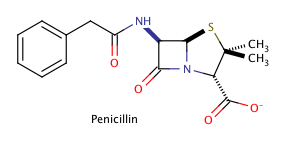Stereochemistry
Help Questions
GRE › Stereochemistry
Which of the following carbons represents the stereogenic center between the given isomers?


Carbon 4
Carbon 5
Carbon 1
Carbon 2
Carbon 3
Explanation
Epimers are isomers that have different configurations at only one carbon atom. This carbon atom is known as the stereogenic center. The given compounds are identical except for the orientation around carbon number 4; thus, carbon 4 is the stereogenic center.
Which of the following carbons represents the stereogenic center between the given isomers?


Carbon 4
Carbon 5
Carbon 1
Carbon 2
Carbon 3
Explanation
Epimers are isomers that have different configurations at only one carbon atom. This carbon atom is known as the stereogenic center. The given compounds are identical except for the orientation around carbon number 4; thus, carbon 4 is the stereogenic center.
Three
One
Zero
Two
Five
Explanation
The correct answer is three. The key to finding chiral carbons is to look for carbons that are attached to four different substituents. We can immediately eliminate any carbons that are involved in double bonds, or that have two hydrogens attached. Given this, we find that there are three chiral carbons. Note that carbon chains of varying content will qualify as different substituents, allowing chiral carbons to bond to two other carbons.
Three
One
Zero
Two
Five
Explanation
The correct answer is three. The key to finding chiral carbons is to look for carbons that are attached to four different substituents. We can immediately eliminate any carbons that are involved in double bonds, or that have two hydrogens attached. Given this, we find that there are three chiral carbons. Note that carbon chains of varying content will qualify as different substituents, allowing chiral carbons to bond to two other carbons.
The molecules shown below are best described as .
isomers
enantiomers
diastereomers
epimers
Explanation
The molecules in this problem are isomers because they each have unique configurations and do not share the same funcitonal groups at the same carbon positions. Enantiomers are reflections of each other. Diastereomers are stereoisomers that differ at one or more stereocenters, while epimers are stereoisomers that differ at only one stereocenter.
The molecules shown below are best described as .
isomers
enantiomers
diastereomers
epimers
Explanation
The molecules in this problem are isomers because they each have unique configurations and do not share the same funcitonal groups at the same carbon positions. Enantiomers are reflections of each other. Diastereomers are stereoisomers that differ at one or more stereocenters, while epimers are stereoisomers that differ at only one stereocenter.
Which of the following is not a geometric isomer of pentene?




All of these are geometric isomers of pentene.
Explanation
Geometric isomers are compounds that have the same molecular formula but they differ in the way they are arranged spatially. Pentene carries the molecular formula, 

 and this compound is not a geometric isomer of pentene.
and this compound is not a geometric isomer of pentene.
Which of the following is not a geometric isomer of pentene?




All of these are geometric isomers of pentene.
Explanation
Geometric isomers are compounds that have the same molecular formula but they differ in the way they are arranged spatially. Pentene carries the molecular formula, 

 and this compound is not a geometric isomer of pentene.
and this compound is not a geometric isomer of pentene.
Compounds that are mirror images of each other are called .
enantiomers
stereoisomers
diastereomers
conformers
Explanation
Stereoisomers are isomers that differ in the orientation of atoms in space, but have the same bonding patterns and structures. Enantiomers are a specific class of stereoisomers that differ in orientation around a chiral center to create mirror image molecules.
Diastereomers are a type of stereoisomer that are not related through a reflection operation, and may differ at more than one chiral center. Conformers have the same structural formula, but different shapes due to bond rotation.
Compounds that are mirror images of each other are called .
enantiomers
stereoisomers
diastereomers
conformers
Explanation
Stereoisomers are isomers that differ in the orientation of atoms in space, but have the same bonding patterns and structures. Enantiomers are a specific class of stereoisomers that differ in orientation around a chiral center to create mirror image molecules.
Diastereomers are a type of stereoisomer that are not related through a reflection operation, and may differ at more than one chiral center. Conformers have the same structural formula, but different shapes due to bond rotation.


